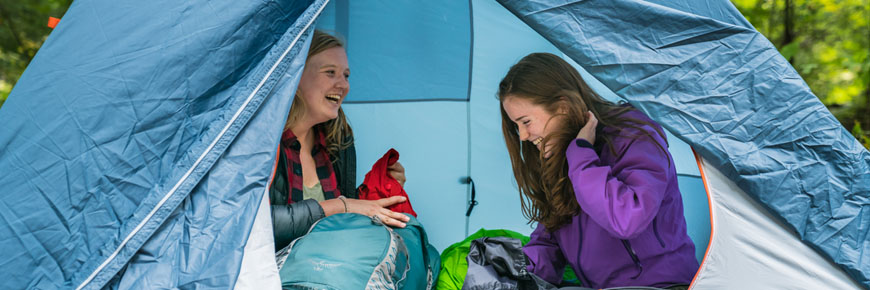
Tents and tarps
Choosing the right tent
Tents come in all shapes and sizes, and in all price ranges. Talk to friends and family members who camp about their experiences. Go to a camping equipment store and look at their tents. Consult with store staff about what would best suit your situation.
Many factors affect the price of a tent, such as capacity, weight, and durability. Before you make a decision, think about how many people you’ll usually go camping with, if you want to drive to a campsite or hike in, or if you’re camping with kids. Little children and adults alike like being able to stand up inside a tent!
Before you leave home
Before you go, practice setting up your tent in the back yard – or even in your living room. Not only will you learn how to put up your tent with all the correct pieces, you’ll also create anticipation for the upcoming trip!
Learn to set up a tent
These steps should help you in setting up your tent. Not all tents are the same but the process is similar in all cases.
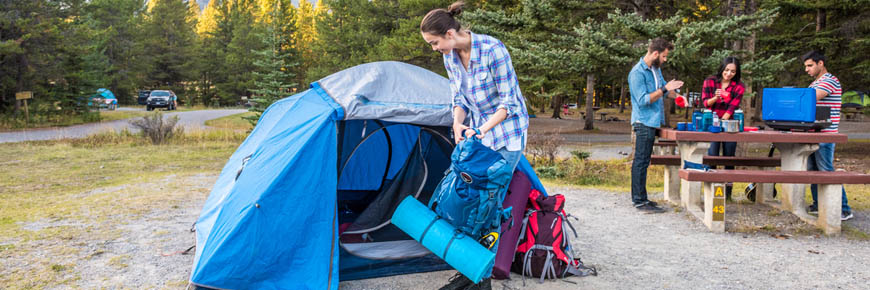
1. Choose your spot
Many Parks Canada campsites have a tent pad which will pre-determine where your tent will go. If not, choose an area that is free of roots, rocks and branches. You’ll have a better night’s sleep if your spot is level and free of sticks and stones. Make sure that the area is far enough away from your fire pit that there is no risk of embers landing on your tent.
Optional - Put down a groundsheet. A groundsheet helps protect your tent and keep you dry.
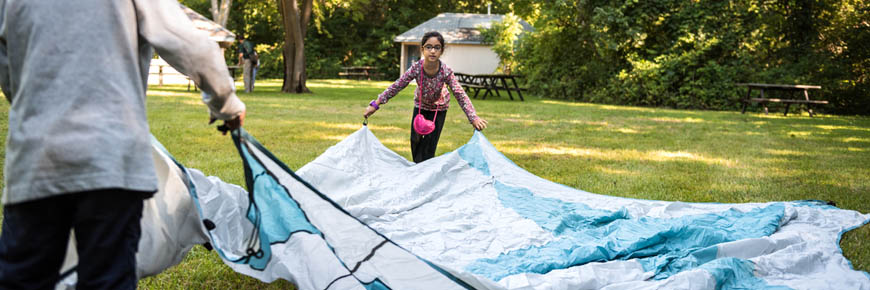
2. Roll out your tent.
Keep in mind where you want your door!
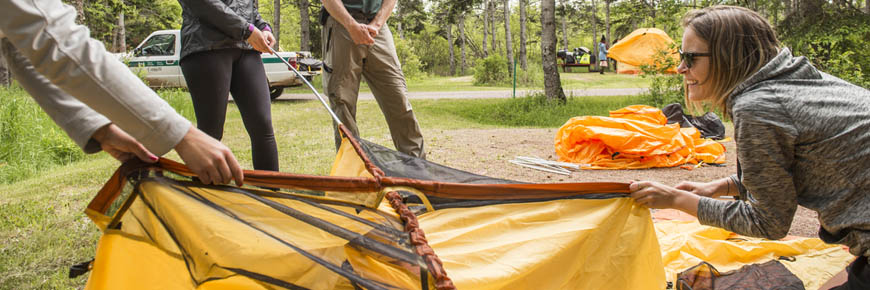
3. Connect your poles
Depending on your tent design, poles slide into sleeves or fasten to clips. If your tent has both sleeves and clips, start with the sleeves. Slide or clip on the two poles that cross at (or near) the top of your tent. If your tent has more than two poles, slide or clip them all in before you begin the next step.

4. Raise your tent
This is the fun part! Start with the two poles that cross at the top. Secure the end of one pole into the special grommet, fabric pocket, or loop at the base of your tent, often at the corner. Bend the flexible pole into an arc and secure the other end – it’s sometimes easier to do this with a partner!
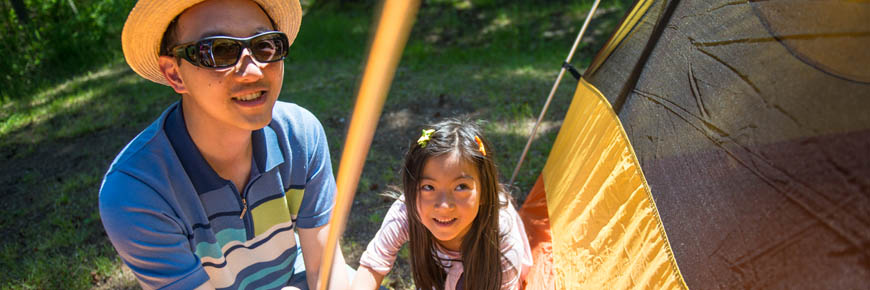
5. Peg the tent to the ground
Most tents have nylon straps with loops or grommets through which you can place a tent peg. Pull the strap away from the tent so the floor is taut. Push the peg into the ground at a 45-degree angle to keep it secure – even on a windy day!
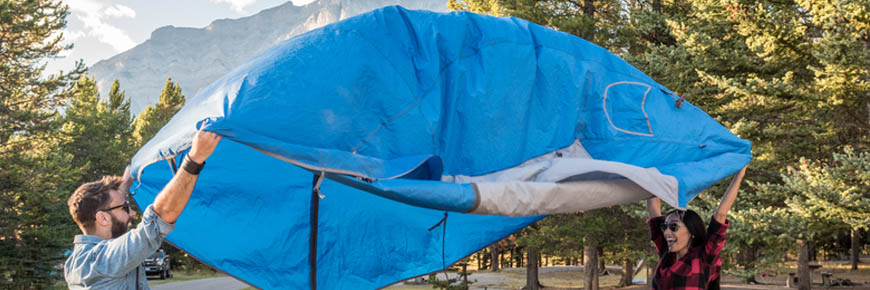
6. Put a fly over the tent
Toss the fly over the tent, keeping your tent door’s location in mind. Depending on the design of your tent, you may need extra pegs, poles or guy lines.
Parks Canada staff tips
Have fun putting up your tent at home – not only will kids love a special sleep-over inside a tent in their living room or backyard, you’ll discover if you have all the pieces you need!
Tent glossary
| Tent glossary | Definition |
|---|---|
| Tent pad | A predetermined area of grass, soil or sand on a campsite where you set up your tent. Your tent pad should be flat and free of debris. |
| Tent body | The main part of the tent, including the walls and floors. Usually made of nylon or polyester. May have mesh for ventilation. |
| Fly | A sheet of waterproof material that fits over the tent body to protect against wind, rain, and sun. |
| Groundsheet | A piece of fabric that goes underneath your tent. A barrier between the tent floor and the ground. Protects your tent over time. Sometimes called a “footprint”. |
| Guy lines | Lengths of cord or rope used to help secure your tent, especially in bad weather. Guy lines are fastened to the fly and then staked into the ground with a tent peg. Guy lines keep the fly taunt and away from the tent walls, which helps ventilation, especially in humid weather. |
| Grommet | A metal ring that reinforces a hole in a piece of fabric. |
| Tent sleeves | Pieces of fabric attached to the tent body or fly into which tent poles go. |
| Tent clips | Devices attached to the tent body and fly that secure the tent poles. |
How-to set up a tent
Transcript
[On an autumn day, three people open the trunk of a car parked on a forest road. The Parks Canada logo, a white circle around a beaver on sitting a log, appears.] Narrator: "Once you arrive at the campsite, you’ll want to choose the best place to raise your tent." [Text on screen: LEARN-TO CAMP, HOW TO SET UP A TENT] [They carry a sleeping bag, a cooler and a blue storage box away from the car.] [Text on screen: STEP 1, EXPLORE THE CAMPSITE] Narrator: "Look for a nice flat spot without any roots or rocks. Avoid hilly sites where water could trickle down and collect into a pool under your tent. Also, be sure to keep a good distance from your fire pit." [Tall trees surround a flat clearing beside a hill descending to a lake. A picnic bench and a fire pit encircled by a metal ring with cutouts of wild animals sit on either side of the clearing.] Narrator: "In your tent bag you should have: the tent body, the tent fly, some poles, pegs and ideally a ground sheet and some guylines." [A rolled tent body, a rolled tent fly, a pile of short metal poles linked with an internal cord, four metal hooks, a rolled ground sheet, and four small rolls of orange cord appear on a picnic table.] [Text on screen: STEP 2, SET UP YOUR TENT] Narrator: "If you have a ground sheet, place it over your selected location. Next, roll out the tent and line up your door in the desired position." [The campers lay out the ground sheet in the clearing. A cooler, a storage box and a sleeping bag sit on the picnic table. Two campers unpack the tent bag and lay the tent body on top of the ground sheet.] [Text on screen: STEP 3, INSTALL THE TENT POLES] Narrator: "After assembling the tent poles, insert one end of a pole into the grommet on the corner of the tent body. Then work your way across the tent by securing the poles using the clips." [One camper takes the bundle of poles out of their bag and connects them to form a larger pole. Later, another camper pops the curved end of the assembled pole through the grommet, a small metal ring attached to a bottom corner of the tent. Then, she lays the pole across the tent and secures it with clips placed at intervals across the body.] Narrator: "Now, attach the end of the pole on the opposite side of the tent to the grommet. This will raise the tent body and is easier when performed by two people. With the first pole attached to the tent, repeat the same steps for the second pole. Some tent models might use a sleeve or a combination of sleeves and clips but the process remains the same." [One camper picks up the pole and lifts the tent, while another camper puts the other end of the pole through the grommet on the opposite side. The pole now forms a semicircle, with the clips holding up the body of the tent. Then, they install the second pole.] [Text on screen: STEP 4, SECURE YOUR TENT TO THE GROUND] Narrator: "Now that your tent is up, you will want to secure it to the ground. Most tents will have nylon webbing straps that loop or have a grommet at their edges. Place a peg through each of the nylon straps along the edge of the tent and pull them away from the tent so that the floor is stretched tight. Now push the peg into the ground at a 45-degree angle. This will ensure your tent stays secure in windy conditions." [Two campers turn the tent to face away from the water. One squats and puts a hooked metal peg through a loop on a corner of the tent. He holds the peg angled towards the tent, hammers it into the ground with a mallet, and repeats the process on another corner.] [Text on screen: STEP 5, ATTACH THE TENT FLY] Narrator: "You will now want to attach the tent fly. It will keep you dry in case of rainy weather. Toss the fly over the tent like a blanket. Make sure that the front of the tent fly lines up with the entrance of the tent. Most flies will attach to the poles of the tent body or to the edges of the tent where the poles are attached." [Two campers unfurl the tent fly and place it over the tent. One camper squats, lifts up the end of one pole, and threads it through a grommet on a corner of the tent fly.] [Text on screen: STEP 6, MOVE IN YOUR GEAR AND ENJOY!] Narrator: "Once the fly is attached, you are ready to move in your bedding and other gear." [One camper stands outside the tent and hands a sleeping bag to another camper sitting inside. Later, all three of them sit on three sleeping bags laid out on the tent floor. They lean together and smile broadly as the one takes a selfie.] [Text on screen: STEP 7, TAKE DOWN YOUR TENT] Narrator: "When it’s time to leave, you’ll want to take everything apart in the reverse order. Make sure to keep all your gear dry and organized and pack it all back into your tent bag." [Two campers unhook the front of the tent fly, pull it over the back of the tent, and unhook the other side. All three pick up the tent, turn the door towards the ground sheet and shake it out. Then, they unclip the tent poles. Later, one camper puts the disassembled poles back into their bag while the other two roll the tent and put it in its bag.] Narrator: "Once everything is packed, do a walk around your campsite to ensure nothing has been forgotten. Also make sure to pick up any garbage you find and leave your campsite as nice as possible. It’s part of the camper's ethic to leave the site in good condition for future visitors." [Leaves blanket the ground of the empty campsite. The campers carry their belongings to the open trunk of their car.] Narrator: "Take only memories. Leave nothing but footprints." [Text on screen: TO LEARN MORE ABOUT THE PARKS CANADA LEARN-TO CAMP PROGRAM, VISIT: PARKSCANADA.CA/LEARNTOCAMP] Narrator: "A message from the Government of Canada." [The Canada Wordmark.]
Parks Canada staff tips
Closing the tent door zippers helps keep out bugs and insects. Remember to take off your shoes before entering the tent to keep it clean.
Tarps
Tarps are one of the most versatile pieces of camping equipment. They can be used in numerous ways to shelter you from the wind, rain, or sun.
Some people hang a tarp over their tents, but you can also hang a tarp over your picnic table to protect yourself from the rain, or enjoy a little spot in the shade.
Setting up a tarp can seem complicated but the following how-to video presents a quick and simple method. Watch carefully and then enjoy your time at camp with this new roof over your head.
How-to set up a tarp
Transcript
[A river flows past a campsite on the edge of a forest in autumn. Three people sit around a picnic table under a tarp suspended by ropes. The Parks Canada logo, a white circle around a beaver on sitting a log, appears.]
Narrator: "When camping, knowing how to set up a tarp is very useful. It can act as your main shelter from the sun, wind and rain."
[Text on screen: LEARN-TO CAMP, HOW TO SET UP A TARP]
Narrator: "Here's what you'll need: a tarp with grommets on all corners, a minimum of 25 metres of paracord, a minimum of 25 metres of rope (or guyline), 4 metal hook tent pegs. Bungee cords are also an excellent alternative."
[Each item appears on a picnic table: an orange waterproof tarp, a roll of white rope, four small rolls of blue cord, and four metal pegs with hooked ends.]
[Text on screen: SET UP YOUR TARP, STEP 1, EXPLORE THE CAMPSITE]
Narrator: "First, explore your campsite and identify two mature trees with sufficiently coarse bark approximately 3 to 5 metres apart, ideally located near your tent or picnic table."
[Two broad trees stand either side of the picnic table at the campsite. A rope tied between the trees holds the orange tarp above the table. A green line extends between the trees with text on top that reads, 3 to 5 metres.]
[Text on screen: STEP 2, ATTACH THE ROOF LINE]
Narrator: "Next, create a roofline. Unroll your paracord and wrap one end around one of the trees as high up as you can reach. Wrap the paracord a minimum of three times around the tree trunk."
[Two campers tie the end of a roll of paracord around one of the tree trunks just above head height. They wind the paracord around the trunk several times and test its strength by pulling it.]
Narrator: "Ensure the rope is nice and tight, then wrap it three times around the second tree. No need to tie a knot, the tension alone will keep the cord securely in place and easy to remove when it’s time to pack up."
[One camper holds the rope taut while the other wraps the end around the second tree trunk several times.]
[Text on screen: STEP 3, HANG THE TARP]
Narrator: "Next, toss your tarp over the newly created roofline so that it hangs equally on both sides."
[The three campers toss the tarp over the rope and adjust it by pulling one side down.]
[Text on screen: STEP 4, TIE THE ROPE]
Narrator: "Lastly, tie the end of each rope or guyline to the grommets on the corners of the tarp. The other end of these should be tied to something close to the ground. These can be other tree trunks or tree roots. Metal camping pegs nestled securely in the ground are a good alternative."
[The campers tie a guyline to each corner of the tarp with a knot and then stretch out the tarp. One camper wraps a guyline around a nearby tree trunk, while another hammers a metal peg attached to a guyline into the ground with a mallet.]
Narrator: "Ensure that the rope remains securely tied to the tarp and to the anchors for all four corners. If you notice the rope is loosening or has lost some tension, be sure to untie and retighten the rope to ensure it stays secure."
[The camper checks the tension of the cord attached to the metal peg by pulling it gently.]
Narrator: "Now enjoy your shelter!"
[The three campers share a meal at the picnic table under the tarp.]
[Text on screen: TO LEARN MORE ABOUT THE PARKS CANADA LEARN-TO CAMP PROGRAM, VISIT: PARKSCANADA.CA/LEARNTOCAMP]
Narrator: "A message from the Government of Canada."
[The Canada Wordmark.]
- Date modified :